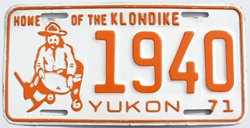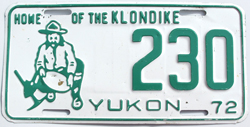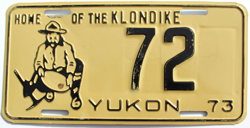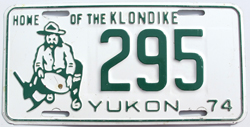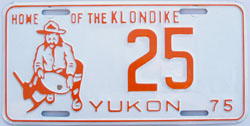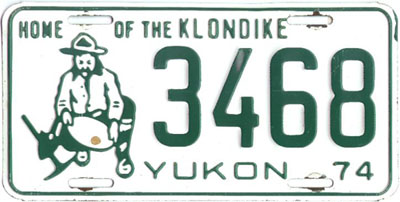Yukon Passenger License Plates
1971 - 1975
On December 5, 1968, the Territory Legislature had passed a Motion (No. 24) "that Council discuss in Committee of the Whole the matter of changing Yukon licence plates' wording from "Land of the Midnight Sun" to "Home of the Klondike"." On October 15, 1969, the Territory wired the Oakalla Prison Farm seeking an additional supply of 100 PSV plates for that year as supplies were running low, and the response from Oakalla provides a rare insight into the manufacturing of licence plates at the facility as well as shedding some further light on the introduction of the "Home of the Klondike" slogan in 1971. In short, the 100 PSV plates could not be filled as Oakalla advised that they had:
While available files have yet to shed any further light on the changing of the slogan, it is thought that the main impetus was the requirement to invest in new dies for the 1971 series, otherwise any recommendation from the Committee of the Whole could have sat unacted upon for many more years.
In the late 1960s, the Klondike Visitors Association (KVA) had promoted the idea of a set of special licence plates to promote the 75th anniversaries of the discovery of gold in the Klondike (in 1971), and "Klondike Stampede" (in 1973). It was suggested to the Director of Travel and Information at this time that the 1971 plates could be gold-on-black, while the 1973 could be gold-on-black with special inscriptions marking each event. Ideally, the costs of this program would be covered by the sale of extra sample plates, however, for reasons unknown, the Director of Travel and Information never forwarded this proposal to the Registrar of Motor Vehicles, H.J. Taylor. So, in 1971 the KVA re-submitted the proposal directly to Taylor for consideration on the 1973 plates. In a memo to staff, Taylor advised that "I don't think there is anything we can do with this. It would be quite expensive to change colours and manufacture new dyes, etc. At any rate, if you feel that something along this line should be done please advise as we will have to commence action immediately." In the interim, the Director of the Tourism and Information Department had also written Taylor in support of moving to gold-and-black colours for 1973 and further suggested that their new logo of a "stylised version of three stampeders climbing the Chilkoot" - which was in the process of being registered - be used on the licence plates "instead of the gold panner." Shortly thereafter, the Deputy Registrar, D.R. Brackenbury, contacted the Oakalla Prison Farm in order to query the additional costs involved in having "either [a] gold background with black border, miner, etc. or to a black background with gold border, miner, etc." displayed on the Territory's licence plates for 1973. Oakalla was also asked to provide a quote on "the cost of changing the die of the miner to some other symbol or approximately the same size." Under the four-year colour scheme cycle that had been established by Oakalla in the late 1960s for Yukon licence plates, the 1973 colours were to have been black-on-yellow (as had occurred in 1969), however, in the interim British Columbia had moved to a white base with coloured letters and numerals, so the economy scale this created favoured the Yukon also using a white background. Not surprisingly, in response to the Territory's request for a gold and black plate, Oakalla advised that the most inexpensive option would be to employ a white background with any colour of ink (already on hand) as this would be approximately $5,745.57 (based upon quantities order in 1972). To otherwise prepare a gold background with black lettering and numbers would be $6,599.74 - which was a 14.9% increase attributable to the "special mill run cost for [a] small quantity of steel." The option of a black background with gold lettering and numbers was to be $7,568.74, or 31.7% more than the first option due to the same special mill costs as well as "all inking of letters and numerals would have to be painted and baked twice because of the poor hiding qualities of gold on black." The cost of replacing the miner was estimated at approximately $500 (the cost of manufacturing the last "miner" die), but was subject to change depending upon the complexity of the new design. In light of this advice, the Territory ultimately opted to go with the black-on-gold colour combination while retaining the "miner" symbol, but requested a sample of the proposed "gold" colouring Oakalla intended to use as the government wanted "to make sure that it is gold colour and not yellow."
|
Christopher Garrish & Ron Garay

